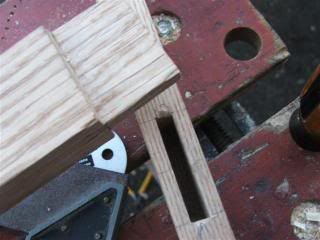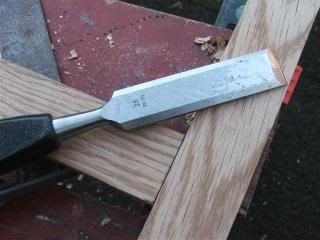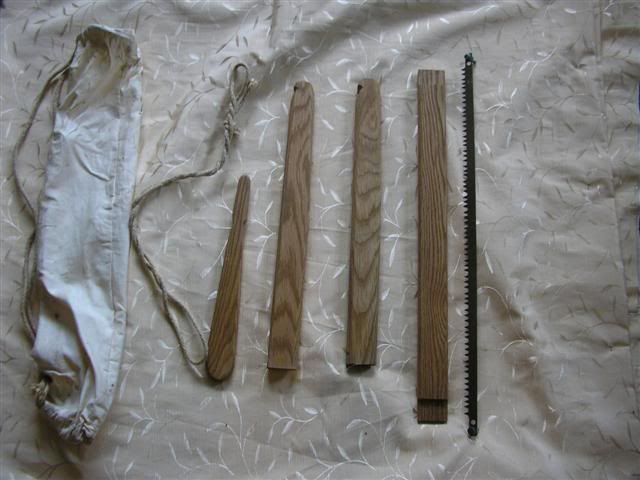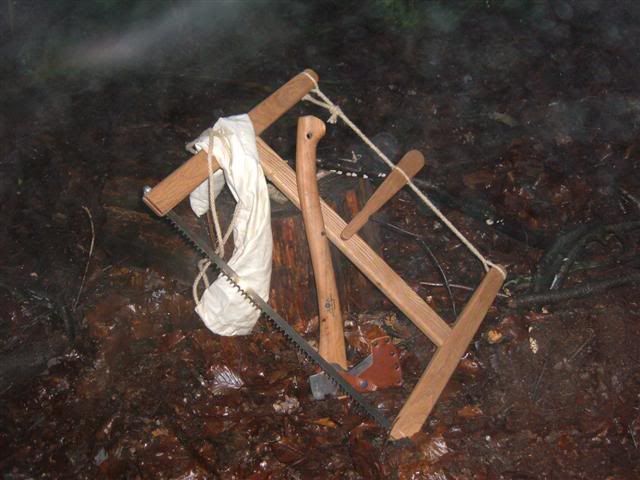Well, I promised to publish my efforts to make a bucksaw
I have set myself a slightly odd challenge, which is to make a robust and stiff frame out of parts that are accessible to all. I'm aiming for under £5 and certainly no more than £10 including the blade
Here are the bits I've got together
I bought two hardwood broom handles, a length of 8mm threaded rod a blade (I got a bulk deal recently a bit of 10mm ally tube and a handful of wing nuts plus two 6mm coach bolts. Say about £6 all up - within a tenner even if I bought the blade retail.
I sawed the two 48 broom handles off into two 24 uprights with the rounded part at the top. One of the off cuts was slightly cut down to make the cross member. The rough layout will be something like this
Now I have measured the cross strut to the exact length of the blade (eye to eye). I wrapped some sandpaper around an offcut of the broom and "indented" each end of the cross strut so it will fit tightly against the upright like this
This leaves the end of cross member this shape
So the fit comes like this
I'll lock the cross member in with a "pin and socket" arrangement using some threaded bar and a hole in the upright. More on that later.
So we have two uprights and a cross member that fits snugly between them. Time to get the drill out. A 10mm hols (the same size as the ally tube) is drilled right through the top of each uprights.
Another hole is drilled halfway through the upright about a third of the way from the top. The measurement needs to be the same on both sides.
Next job is to cut some lengths of ally tube the right size to line these holes
These are glued in place (super glue works fine, but rough up the outside of the tube first to give it a key). The tube is then filed and sanded to the contour of the wood (ally is soft so this doesnt take long)
Right thats the hole at the top done for the tensioner and the sockets further down for the cross strut.
Next I clamped the cross strut and drilled a ¾ hole in each end
A piece of threaded rod was glued into this hole as shown below
This stud fits into the socket created earlier.
Next step is to turn the upright over. A 6mm hole is drilled through the upright at 90 degrees to the through hole drilled earlier. This is for the 6mm coach bolt that holds the blade in place. A saw cut is made to the correct depth to slot the blade in. A bit of trial and error is required to make the cut the right depth to align the coach bolt hole and saw blade hole.
Thats pretty much it for construction. I then rubbed the whole thing down and gave it a wipe with some woodstain and then waxed it for protection
To assemble, bolt the blade in place, slot the cross member into the sockets and slide the threaded rod through the lined holes. Tighten the butterfly nuts at each end of the threaded bar and you are good to go. You will notice in the finished picture that the uprights are slightly bowed. This puts a great tension on the saw blade.
I guess theres no more than an hours work in this and, if a klutz like me can do it, anyone can. The saw really does work very well with no twisting which I suspect is to do with the slight flex tensioning the wood
Don't know how long it will hold up - slightly thicker wood might be an idea, but I'm happy enough for a first go
Not as pretty as some of those posted, nor as strong as others nor as well made as any I suspect. Not an entry either though

. I hope it encourages someone else to try and deprive me of my axe however

Red













 . I hope it encourages someone else to try and deprive me of my axe however
. I hope it encourages someone else to try and deprive me of my axe however  time to get it worked on!
time to get it worked on!























